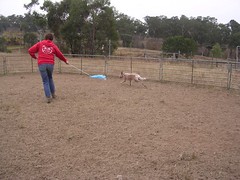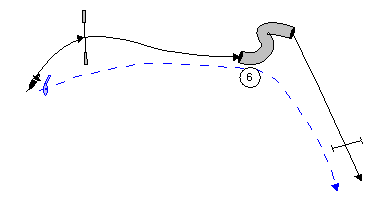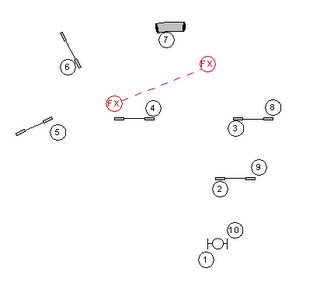
Dusty was playing chasing games at a friends property. She would run past the older dogs and take off as though they were chasing her. They weren't.
Choosing and training a puppy for agility, herding, obedience, and companionship.


Trent captured Dusty and I discussing how we were going to handle the flock - left up to her she would only go anticlockwise.
Once we had sorted out our handler paths and body language even the young dogs had no problem with the sequence.
 A gold star indicates that this dog scored within the normal range.
A gold star indicates that this dog scored within the normal range. A red flag indicates that this dog obtained a less favorable score for this subscale than at least 75% of the dogs in the comparison sample.
A red flag indicates that this dog obtained a less favorable score for this subscale than at least 75% of the dogs in the comparison sample. Two red flags indicate that this dog obtained a less favorable score for this subscale than at least 90% of the dogs in the comparison sample.
Two red flags indicate that this dog obtained a less favorable score for this subscale than at least 90% of the dogs in the comparison sample.
With Thommo I do a stand stay. This seemed to be the position he was most comfortable with, probably as a result of playing Ready, Set, Go games where he would be standing beside me, and of many hours of him standing and waiting while a threw a ball, then gave the OK to fetch.
With Dusty I'm using a down stay at the start, again because this seems to be a default behaviour for her, and one the first stay we learned as she needed to do a down stay in the presence of sheep to get her Herding Instinct Certificate. I guess I could insist on a sit-stay with either of them, and work to reinforce it and proof it. But why not start from a position they are already comfortable with.
There is some debate over what is the fastest start. Nancy Geyes recommends a sit-stay, saying that she finds it easier to teach a reliable, square, sit-stay, than a stay in a stand or down position. Chris Zink says that dogs that are left standing at the line first trot and then have to shift into a canter before jumping (jumping is an extension of the canter). This wastes some time and also makes it more difficult for the dogs to judge the correct take-off point. In contrast, dogs that are left sitting go straight into a canter and are ready to jump without having to shift into a different gait.
This may be true where the dog stands flat footed, or lies down belly on the ground, but my dogs wait in a sort of crouch: Thommo in a stand slightly lowered, Dusty in a down slightly raised. Most herding dogs adopt this sort of pose in a wait.
Greg Derrett advocates a standing start. He also says to have a routine which incorporates the dog's natural behaviour. He brings the dog to the start line then stands them with a gentle scruff.